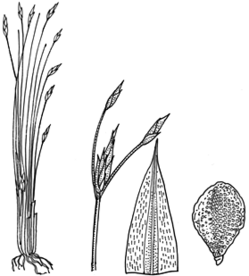Fimbristylis vaginata (R.Br.) Domin APNI* Synonyms: Abildgaardia vaginata R.Br. APNI*
Fimbristylis brownii Benth. APNI*

Description: Glabrous, tufted perennial. Culms compressed, smooth, filiform, 3–40 cm long, 0.2–0.5 mm diam.
Leaves reduced to sheaths.
Inflorescence consisting of 1 sessile spikelet plus 1–5 spikelets on branches to 2 cm long; involucral bracts glume-like, 1 or 2, much shorter than inflorescence. Spikelets erect, ovoid, acute, ± compressed, 8–18 mm long, 2–3 mm diam. Glumes membranous, acute, mucronulate, numerous-nerved near midrib, 5.5–7.5 mm long, pale red-brown, with broad hyaline (often red-dotted) margins. Stamens 3; anthers 2.5–4 mm long. Style glabrous, 5–7 mm long.
Nut trigonous, obovoid, c. 1.5 mm long, c. 1 mm diam., tuberculate, with minute isodiametric reticulations, pale brown to dark grey-brown.
Flowering: Nut trigonous, obovoid, c. 1.5 mm long, c. 1 mm diam., tuberculate, with minute isodiametric reticulations, pale brown to dark grey–brown.
Distribution and occurrence: Coast north from Grafton area; also in Qld and NT; New Guinea. Grows in woodland near creeks, on sandy soil.
NSW subdivisions: NC
| Flora of NSW 4 (1993) as Abildgaardia vaginata |
APNI* Provides a link to the Australian Plant Name Index (hosted by the Australian National Botanic Gardens) for comprehensive bibliographic data
***The AVH map option provides a detailed interactive Australia wide distribution map drawn from collections held by all major Australian herbaria participating in the Australian Virtual Herbarium project.
|


